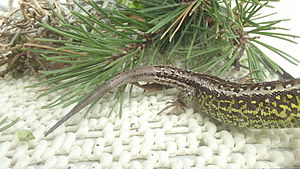Autotomy
As Autotomy ( Greek αυτοτομία autotomía = "self-Tailoring") in animals is defined as the ability of some species to throw off a body part at risk. Depending on the group of animals, the body part that is thrown off then grows back completely, incompletely or not at all ( regeneration ).
Examples
- Lizards can shed their tails when in danger. This continues to move several minutes after being dropped in order to attract the attention of a predator, while the “remaining” lizard can escape. Most of the time the tail only grows back in a shortened form.
- Two African spiny mouse species , Acomys kempi and Acomys percivali , can counteract access by predators through their skin, which can be stripped off without great resistance. This makes them the first mammals to have autotomy of the skin demonstrated. All layers of the lost skin can be completely regenerated with little to no scarring, including hair follicles, sweat glands and others. These properties are currently being investigated for application in human wound healing.
- Some sleep mice can peel off their tail skin when grabbed and escape.
- Earthworms, and also mud tube worms, can cut off some segments of their body at the rear end, which are later regenerated.
- Discarded legs only grow back in some species of harvestmen ; therefore one often sees harvestmen with fewer than eight legs.
- Many species of ghosts have the ability to throw off extremities at designated break points between the thigh and thigh ring and to replace them piece by piece during the next molt .
- If harp snails are attacked, they shed part of the foot, which continues to move and distracts the predator.
- Starfish can pinch off individual body parts. In this way, they are also able to reproduce asexually, as new individuals can emerge from shed parts in some species ( fissiparia ).
- Sea cucumbers can pinch off parts of their internal organs and regenerate them.
- Common rush larvae can shed their gill leaves in case of danger. They regenerate with the following moults.
swell
- ↑ Wilfried Westheide , Reinhard Rieger (Ed.): Special Zoology. Part 1: Protozoa and invertebrates , 2nd edition, Spektrum Akad. Verl., Heidelberg et al. 2007, ISBN 978-3-8274-1575-2 .
- ↑ doi : 10.1038 / nature11499
- ↑ Zoe Cormier: African spiny mice can regrow lost skin , Nature . September 26, 2012. Retrieved September 27, 2012.
- ↑ Juskaitis Rimvydas, Sven Büchner: The Haselmaus: Muscardinus avellanarius . Westarp Sciences, 2010.
- ^ Bernhard Grzimek : Grzimeks animal life. Volume 2: Insects. Unchanged reprint. Deutscher Taschenbuchverlag, Munich 1993, ISBN 3-423-05970-2 .
- ^ Rainer Buchwald, Klaus Sternberg: Die Libellen Baden-Württemberg. Volume 1: General Part. Dragonflies (Zygoptera). Ulmer, Stuttgart 1999, ISBN 3-8001-3508-6 .
- ↑ R. Stoks, M. De Block: The influence of predator species and prey age on the immediate survival value of antipredator behaviors in a damselfly. In: Archives for Hydrobiology. Vol. 147, No. 4, ISSN 0003-9136 , pp. 417-430.
